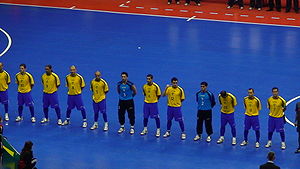I signed up to participate in a futsal match this saturday night (what was I thinking? Me playing Futsal?? haha)
So, let's educate ourselves on the history and rules of the futsal game.
Futsal is a variant of association football that is mainly played indoors. Its name is derived from the Portuguese fut ebol de sal ão and the Spanish fút bol sal a/de sal ón, which can be translated as 'salon football'. In Madrid 1985 the name fútbol de saló and all other names the game was called were changed officially and internationally into FUTSAL.
Futsal is played between two teams of five players, one of whom is the goalkeeper, and up to seven substitutes per team. Unlike some other forms of indoor football, the game is played on a hard court surface delimited by lines; walls or boards are not used. Futsal is also played with a smaller ball with less bounce than a regulation football.The rules create an emphasis on improvisation, creativity and technique as well as ball control and passing in small spacesHistory
Futsal was started in Montevideo, Uruguay, in 1930 when Juan Carlos Ceriani created a version of football for competition in YMCAs.[3] In Brazil, this version developed on the streets of Sao Paulo, and eventually a rule book was published. The sport began to spread across South America, and its popularity ensured that a governing body was formed under the name of FIFUSA (Federación Internacional de Fútbol de Salón) in 1971, along with the World Championships. The first FIFUSA World Championships were held in São Paulo, with hosts Brazil crowned champions ahead of Paraguay and Uruguay. Even more countries participated in the second World Championships held in Madrid in 1985.[4] Due to a dispute between FIFA and FIFUSA over the administration of fútbol, FIFUSA coined the word fut-sal in 1985.
FIFA took control of the World Championships in 1989. Under new rules made by FIFA, the technical aspects of the game for players and spectators were improved. The linesmen were replaced with a second referee and there were unlimited substitutions.[5] It also introduced a size 4 football, which was weighted to reduce bounce by 30% compared to a conventional ball, which enabled faster play and, for the first time, scoring goals with the head.
As international governing bodies of futsal, FIFA and AMF are responsible for maintaining and promulgating the official rules of their respective versions of futsal. Like football, futsal has 'laws' that define all aspects of the game, including what may be changed to suit local competitions and leagues. There are seventeen laws in the Futsal Laws of the Game.[8]
Players, equipment and officials
There are five players on each team, one of whom is the goalkeeper. The maximum number of substitutes allowed is seven, with unlimited substitutions during the match. Substitutes can come on even when the ball is in play.[9] If a team has fewer than three players in the team, the match is abandoned.[10]
The kit is made up of a jersey or shirt with sleeves, shorts, socks, shinguards made out of rubber or plastic and shoes with rubber soles. The goalkeeper is allowed to wear long trousers and a different coloured kit, to distinguish himself from the other players in the team and the referee. Jewellery is not allowed, as are other items that could be dangerous to themselves or other players.[11]
The match is controlled by a referee who enforce the Laws of the Game, and the first referee is the only one who can abandon the match because of interference from outside the pitch. This referee is also assisted by a second referee. The decisions made by the referees are final, and can only be changed if the referees think it is necessary and play has not restarted.[12] There is also a third referee and a timekeeper, who are provided with equipment to keep a record of fouls in the match. In the event of injury to the referee or second referee, the third referee will replace the second referee. [13]
The pitch
The pitch is a made up of wood or artificial material, although any flat, smooth and non-abrasive material may be used. The length of the pitch is in the range 38–42 m (42-46 yd) and the width is in the range 18-25m in international matches. For other matches, it can be from 25-42m (27-46 yd)in length, while the width can be 15-25m (16-27 yd), as long as the length of the longer boundary lines (touchlines) are greater than the shorter boundaries where the goals are placed (goal lines)[14]. The ceiling must be at least 4 m (4 yd) high.[15] A rectangular goal is positioned at the middle of each goal line. The inner edges of the vertical goal posts must be 3 m (3 yd) apart, and the lower edge of the horizontal crossbar supported by the goal posts must be 2m (2 yd) above the ground. Nets made of hemp, jute or nylon are attached to the back of the goalposts and crossbar. The lower part of the nets shall be attached to curved tubing or another suitable means of support. The depth of the goal is 80 cm at the top and 1m at the bottom.[16]

source: wikipedia

No comments:
Post a Comment